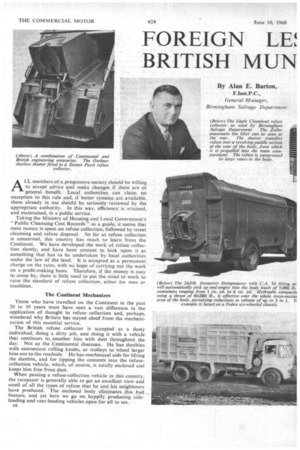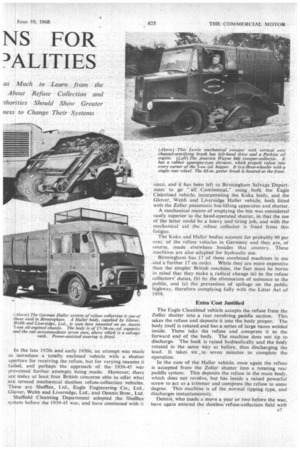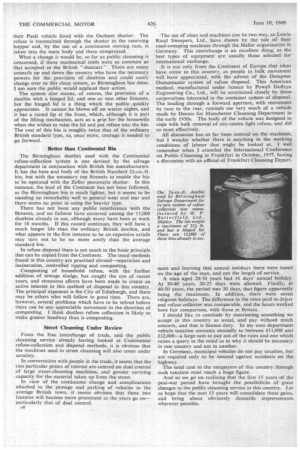FOREIGN LE!
Page 74

Page 75

Page 76

If you've noticed an error in this article please click here to report it so we can fix it.
BRITISH MUN NS FOR
3ALITIES
By -Man E. Barton,
. . General Manager, Birmingham Salvage Department ALL members:of a progressive society should be willing. to accept advice and make changes if these are of general benefit. Local authorities can, claim no exception to this rule and, if better systems are available,. . those already in use should be seriously reviewed by the
appropriate authority. In this way, efficiency is attained,.
and maintained, in a public service. • Taking the Ministry of Housing and Local Government's " Public Cleansing Cost Records" as a.guide, it. seems that most money is spent on refuse collection, followed by street cleansing and refuse disposal. So far as refuse collection is concerned, this country has much to, learn from the Continent. We have developed the work of refuse collec tion slowly, and have been content to look upon it as something that has to be undertaken by local authorities. under the law of the land.. It is accepted as a permanent charge on the rates, with no hope of carrying out the work on a profit-making basis. Therefore, if the money is easy to come by, there is little need to put the mind to work to raise the standard of refuse collection, either for men or machines.
The Continent Mechanizes Those who have travelled on the Continent in the past 20 to 30 years must have seen a vast difference in the application of thought to refuse collection and, perhaps, wondered why Britain has stayed aloof from the mechanization of this essential service.
The British refuse collector is accepted as a dusty individual, doing a dirty job, and doing it with a vehicle that continues to_smother him with dust throughout the day. Not so the Continental dustman. He has dustbins with convenient rolling knobs, or trolleys to wheel larger bins out to the roadside. He has mechanical aids for lifting the dustbin, and for tipping the contents into the refuse collection vehicle, which, of course, is totally enclosed and keeps him free from dust.
When passing a refuse-collection vehicle in this country, the ratepayer is generally able to get an excellent view and smell of all the types of refuse that he and his neighbours have produced. The enclosed body eliminates this bad
feature, and yet here we go on happily producing side.. loading and Tear-loading vehicles open for all to see.
In the late 1920s and early 1930s, an attempt was made to introduce a totally enclosed vehicle with a shutter aperture for receiving the refuse, but for varying reasons it failed, and perhaps the approach of the 1939-45 war prevented further attempts being made. However, there are today at least four British concerns able to oiler what are termed mechanical dustless refuse-collection vehicles. These are Shefflex, Ltd., Eagle Engineering Co., Ltd., Glover, Webb and Liversidge, Ltd., and Dennis Bros., Ltd.
Sheffield Cleansing Department adopted the Shefflex system before the 1939-45 war, and have continued with it
• sinee, and it has been left to. Birmingham Salvage Department to go `,` allContinental,using both the Eagle = Cleafiload vehicle, incorporating the Kuka _body, and the Glover, Webb and Liversidge Haller vehicle, both fitted with the Zoller pneumatic bin-lifting apparatus and shutter. A.mechanical means of emptying the bin was considered vastly superior to the hand-operated shutter, in that the use of the latter could be a heavy and tiring job, and with the
• mechanical aid the refuse collector is freed from this fatigue.
• The Kuka and Haller bodies account for probably 90 per cent. of the refusevehicles in Germany and they are, of course, made elsewhere besides that country. These machines are also adapted for hydraulic use.
Birmingham has 17 of these combined machines in use and altirther 17 on order. While they are more expensive than the simpler British _machine, the fact must be borne in mind that they make a radical change (a) to the refuse collectors' duties, (b) by the elimination of nuisance to the public, and (c) the prevention of spillage on the public highway, therefore complying fully with the Litter Act of 1958.
Extra Cost Justified
The Eagle Cleanload vehicle accepts the refuse from the Zoller shutter into a rear revolving paddle section. This takes the refuse and deposits it into the body proper. The body itself is rotated and has a series of large vanes welded inside. These take the refuse and compress it to the forward end of the body. The machine does not tip to discharge. The back is raised hydraulically and the body rotated in the same way as before, thus discharging the load. It takes six to seven minutes to complete the operation.
In the case of the Haller vehicle, once again the refuse is accepted from the Zoller shutter into a rotating rear paddle system. This deposits the refuse in the main body, which does not revolve, but has inside a raised powerful screw to act as a trimmer and compress the refuse to some degree. This machine is of the normal tipping type, and discharges instantaneously.
Dennis, who made a move a year or two before the war, have again entered the dustless refuse-collection field with their Paxit vehicle fitted with the Oschner shutter. The refuse is transmitted through the shutter to the receiving hopper and, by the use of a continuous moving ram, is taken into the main body and there compressed.
What a change it would be, so far as public cleansing is concerned, if these mechanical tools were as common as that accepted as the British "dustcart." There are many councils up and down the country who have the necessary powers for the provision of dustbins and could easily change over to this clean system, as Birmingham has done. I am sure the public would applaud their action.
The system also means, of course, the provision of a dustbin with a hinged lid, and one or two other fitments, but the hinged lid is a thing which the public quickly appreciates. It cannot be blown off on winter nights, and it has a raised lip at the front, which, although it is part of the lifting mechanism, acts as a grin for the housewife when she wishes to raise the lid and put refuse into the bin. The cost of this bin is roughly twice that of the ordinary British standard type, so, once more, courage is needed to go forward.
Better than Continental Bin The Birmingham dustbin used with the Continental refuse-collection system is one devised by the salvage department in conjunction with British bin manufacturers. It has the base and body of the British Standard 21-cu.-ft. bin, but with the necessary top fitments to enable the bin to be operated with the Zoller pneumatic shutter. In this instance, the lead of the Continent has not been followed, as the Birmingham bin is much -lighter, but it seems to be standing up remarkably well to general wear and tear and there seems no point in using the heavier type.
There has not been any public interference with the fitments, and no failures have occurred among the 15,000 dustbins already in use, although many have been at work for 18 months. If this record continues, they will have a much longer life than the ordinary British dustbin, and what appears in the first instance to be an expensive article may turn out to be no more costly than the average standard bin.
In refuse disposal there is not much in the basic principle that can be copied from the Continent. The usual methods found in this country are practised abroad—separation and incineration, controlled tipping and composting.
Composting of household refuse, with the further addition of sewage sludge, has caught the eye of recent years, and strenuous efforts have been made to create an active interest in this method of disposal in this, country. The principal exponent is the City of Edinburgh, and there may be others who will follow in good time. There are, however, several problems which have to be solved before there can be any appreciable movement in the direction of composting. I think dustless refuse collection is likely to make greater headway than is composting.
Street Cleansing Under Review
From the free interchange of trade, and the public cleansing service already having looked at Continental refuse-collection and disposal methods, it is obvious that the machines used in street cleansing will also come under scrutiny.
In conversation with people in the trade, it seems that the two particular points of interest are centred on dual control of large street-cleansing machines, and greater carrying capacity for the material taken up from the street.
In view of the continuous change and complications attached to the passage and parking of vehicles in the average British town, it seems obvious that these two features will become more prominent as the years go on— particularly that of dual control.
E8 The use of ideas and machines can be two-way, as Lewin Road Sweepers, Ltd., have shown •by the sale of their road-sweeping machines through the Haller organization in Germany. This interchange is an excellent thing, as the best types of equipment are usually those selected for international exchange.
It is not only from the Continent of Europe that ideas have come to this country, as people in bulk movement will have appreciated, with the advent of the Dempster Dumpmaster system of refuse disposal. This American method, manufactured under licence by Powell Duffryn Engineering Co., Ltd., will be scrutinized closely by those corporations interested in the container system of disposal. The loading through a forward aperture, with movement by ram to the rear, reminds me very much of a vehicle made by Dennis for Manchester Cleansing Department in the early 1950s. The body of the vehicle was designed to cope with bulk removal of city-centre light refuse, and did so most effectively.
All discussion has so far been centred on the machines, but I wonder whether there is anything in the working conditions of labour that might be looked at. I well remember when I attended the International Conference on Public Cleansing in Frankfurt in October, 1957, having a discussion with an official of Frankfurt Cleansing Depart ment and learning that annual holidays there were based on the age of the man, and not the length of service.
A man aged 20-30 years had 16 days' annual holiday. At 30-40 years, 20-25 days were allowed. Finally, at 40-50 years, the period was 30 days, that figure apparently being the maximum. In addition, there were seven religious holidays. The difference in the rates paid to driyer and refuse collector was comparable, and the hours worked bore fair comparison, with those in Britain.
I should like to conclude by mentioning something we accept in this country as usual, and pay without much concern, and that is licence duty. In my own department vehicle taxation amounts annually to between £11,000 and £12,000—a large sum to pay out of the rates and one which raises a query in the mind as to why it should be necessary in one country and not in another.
In Germany, municipal vehicles do not pay taxation, but are required only to be insured against accidents on the highway.
The total cost to the ratepayers of this country through such taxation must reach a huge figure.
And so we go on realizing that the first 15 years of the post-war period have brought the possibilities of great changes to the public cleansing service in this country. Let us hope that the next 15 years will consolidate these gains, and bring about obviously desirable improvements wherever possible.




















































































































































